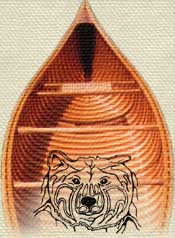Please take a few minutes to read the following suggestions that will help make your canoe last for generations to come. The best advice we can give you is: use it!
One of the simplest things you can do to protect your canoe’s gunwales, is to properly pad your roof rack. For many of the contemporary racks, the most economical and efficient way to do this is to use the foam pipe insulation available in hardware stores. It’s easily cut to length and fastened with duct or electrical tape.
Bits of scrap carpet fastened to wooden racks is another easy way to protect any cargo strapped to the roof of your vehicle.
Many people use the cheap polyethylene (yellow) rope that cannot be tensioned, does not hold a knot and is extremely abrasive. Please, protect your boat and others sharing the road: use proper tie-downs or flexible braided nylon rope and learn the trucker’s hitch!
Between outings, keep your canoe up off the ground on a rack and preferably in the shade. This practice will go a long way to keeping wood rot at bay, as well as increasing the longevity of the paint and varnish. If you have a boat house, honour your canoe with this coveted location.
Take care also when tying your canoe along a dock or rocky shore. Waves and swells produced by motorized boats or strong winds can push your boat against rocks or worse, protruding nails in a dock, causing wear on the paint and varnish, or tears in the canvas.
For our canvas covered canoes, we strongly believe in the tradition of the original canvas fillers made from an oil based recipe. The canoes made with these fillers are known for their longevity and rot resistance. The oil based fillers can be painted in about 4 weeks, yet require several more weeks to obtain ultimate waterproofness.
So, while the canoe’s exterior surface is solid and the canoe fully functional, the interior of the canvas continues to cure well into its first season on the water. Try to avoid getting the interior wet. If you do (and of course you will!), take caution to not leave your canoe in the sun, flipped upside down. The heat of the sun’s rays will cause any moisture to evaporate and attempt to escape through the outer layers. This may create blisters in the impermeable layer of paint.
Where feasible, leave your canoe upright in the shade to allow the moisture to evaporate. It is advisable to adhere to this practice for the first paddling season.
This does not apply to Dacron covered canoes.
In the off season, store your canoe under cover in a dry, preferably unheated place: in a boathouse, garage, under a lean-to, or the living room of your summer cottage. Put you canoe gunwale-side down (this helps maintain the canoe’s shape) on a rack or saw horses that have been covered with soft material such as carpet end pieces or layers of old flannel sheets.
We apply 4- 5 coats of superior marine varnish to the gunwales. Unless subjected to constant rubbing of the paddle, or careless handling, the gunwales should last several seasons before needing a refresher coat.
For those who enjoy a bit of regular maintenance, a yearly touch-up coat of spar varnish will go a long way to protecting the gunwales and enhancing their beauty. It’s an easy procedure, and takes about 2 hours. Please avoid using urethanes as they do not adhere well and do not provide the flexibility required for a canoe.
